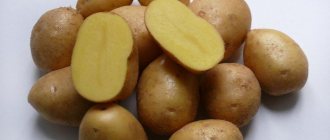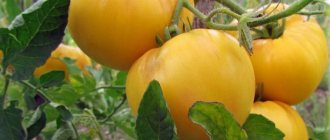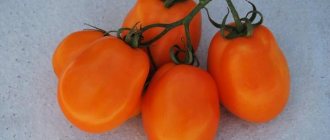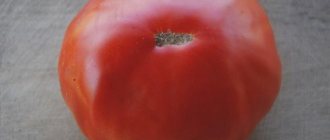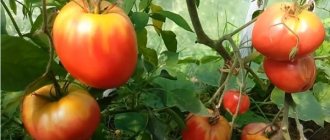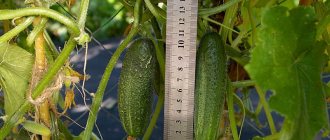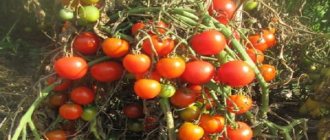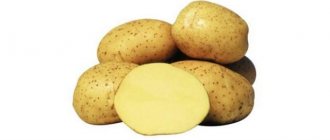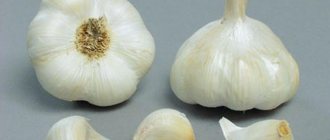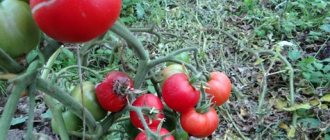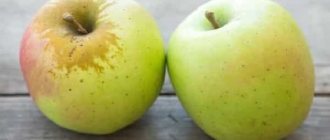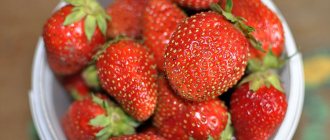It happens that a variety that gardeners love is grown for years and does not lose popularity. This is the zucchini variety Iskander F1. It is unpretentious in care, has good productivity and boasts excellent taste.
Let's give a description of the zucchini and the characteristics of the variety. Let us tell you some of the subtleties of growing it in open ground.
Description and characteristics of the Iskander F1 variety
Zucchini Iskander F1 is an early-ripening bush-type hybrid. From the appearance of the first shoots to the harvest, an average of 40 days pass. At the same time, its fruiting period is very long - until the first frost. Productivity is high – 17 kg/bush. There is resistance to some diseases, drought, and light frosts. Recommended for growing in greenhouses, film tunnels and open ground.
The fruits are cylindrical, narrow, 15-20 cm long
The plant is powerful, but quite compact and erect. The fruits are cylindrical, narrow, 15-20 cm long. The surface is smooth, the ribbing is poorly developed. The squash tapers slightly at the stem. The main part of the peel is greenish with an abundance of veins and specks. The weight of one vegetable is 480-640 grams. The pulp is always dense, creamy white. The taste is excellent.
Characteristics of fruits and yield of the zucchini variety Iskander
The Iskander F1 hybrid stands out from the rest due to its “fertility.” The yield of the variety can reach 17 kg per bush. It is in the first positions in terms of fruiting period. Harvesting is recommended to be done in a timely manner, before the first frost appears.
Photo of Iskander zucchini harvest on a bush
You don’t have to wait until the fruits fully ripen. Young zucchini, more than 10 cm long, with a fallen flower, have excellent taste.
The zucchini must be carefully cut, and under no circumstances should you try to pull it out with your hands (it’s still not a turnip). It is enough to make a cut at a level of 4-5 cm from the end of the stalk.
Good varieties of carrots!
Autumn King Flakke
You can store Iskander zucchini for up to 5 months.
The following conditions are required for this:
- It is recommended to pick vegetables for storage when they are fully ripe;
- The temperature in the storage room should not exceed 10 degrees;
- Dry indoor atmosphere.
By providing optimal conditions for the plant, in return you can get a rich yield of high quality.
In general, my attitude towards the Iskander zucchini variety is positive
. I've been growing it for three years now. There are no particular difficulties with planting, growing, or caring for them. The fruits ripen quickly. I really like the delicate and soft taste. It distinguishes the Iskander variety from other zucchini. In my opinion, this variety has no analogues and produces fruits of very high quality.
Excellent productive variety!
Zucchini variety “Roller”
How to plant Iskander F1 zucchini?
Also check out these articles
- Cucumber Masha F1 and its characteristics
- Grape variety Jubilee Novocherkassk
- Garlic variety Gribovsky
- The best varieties of peas
Iskander F1 zucchini grows best in light, fertile soil with low or moderate acidity. Groundwater should be located as low as possible, since an abundance of moisture will lead to rotting of the root system. Planted after onions, tomatoes, potatoes, carrots and beets.
Iskander F1 zucchini grows best in light, fertile soil with low or moderate acidity
Sowing seeds in open ground always occurs at the end of May or beginning of June. Crops can be planted in greenhouses and film tunnels from the beginning of April. If planting is delayed, the plant will develop slowly and may produce little yield - the ovaries appear at low temperatures, and in the heat you cannot expect them. However, earlier planting can lead to freezing of the crops during the first belated frosts, since this variety of zucchini cannot withstand significant drops in temperature.
Separate holes are prepared for planting at a distance of 60 cm from each other in a checkerboard pattern. If the soil was not fertilized in the fall or 2 weeks before planting the crop, it is worth putting about a piece of humus or compost in each hole, mixing it well with the soil and pouring water warmed in the sun.
2-3 seeds are planted in each hole to a depth of 4-5 cm so that seedlings are sure to appear. Then they are sprinkled with earth to a depth of about 4 cm. There is no need to treat Iskander F1 zucchini seeds in advance if the company is trusted, and the seeds have been processed at the factory for their production (indicated on the packaging). Otherwise, you can soak them before planting for 30 minutes in a solution of potassium permanganate or an infusion of wood ash.
Growing zucchini Iskander
There are 2 ways to plant Iskander zucchini: grow seedlings or sow seeds in open ground.
Planting zucchini using the seedling method gives a larger harvest due to the early stages of their ripening. In order for the seeds to germinate faster and the seedlings to be strong, it is important to prepare them by soaking them in warm water for 24 hours, and then keeping them in a damp cloth for several days at a temperature of +25 degrees. You also need to harden the seed by placing it in the lower compartment of the refrigerator for 2-3 days.
You can buy a soil mixture in a store or prepare it yourself from peat, humus, sawdust in a ratio of 5:4:1 and add a little wood ash and ammonium nitrate. The substrate also needs to be disinfected by pouring a hot infusion of strong potassium permanganate. Fill the containers with the prepared substrate, water with warm, settled water and plant the seeds in them to a depth of 3-4 cm.
On a note! It is better to grow seedlings in peat pots, at least 10x10 cm in size.
Seedling care:
- Creation of optimal temperature conditions. Before emergence, the temperature in the room with crops should be within 18-25 °C. When the sprouts form, within 4-5 days - 15-20 °C during the day, and at night - 12-15 °C. Then, before planting in the ground, the temperature should be maintained at 17-22 °C during the day and 13-17 °C at night.
- Watering. It is necessary to moisten the soil only with warm water every 5 days, using 1 liter for 8 plants.
- Fertilizer application. The first fertilizing should be carried out a week after emergence (0.5 tsp of urea per 1 liter of water, consumption - 120 ml per plant). The second should be done in another week (1 tsp. Nitrophoska per 1 liter of water, consumption - 250 ml per plant).
Is it necessary to make seedlings?
When planted in open ground or a greenhouse with seeds, the Iskander F1 variety squash produces excellent seedlings and ripens quickly, so seedlings are usually not made if the product is grown for personal consumption. If the vegetable is needed for sale, you can prepare seedlings, but preferably in peat cups, since young plants of this species do not like replanting.
You can prepare seedlings, but preferably in peat cups, since young plants of this species do not like replanting
They begin to grow seedlings from the beginning of March, so that within a month they can be transplanted into a greenhouse or greenhouse. If the crop is cultivated directly in the open air, harvesting should be postponed until mid-April. It is grown for 1 month, then transplanted into separate holes. If the seedlings are weak, you can plant 2 sprouts in each hole, rather than one at a time, just to be on the safe side.
Growing methods
There are several ways to plant Iskander zucchini, the main thing is to know the characteristics of each and follow a certain algorithm of actions.
Planting in open ground
You can plant seed material directly onto a prepared bed in dry form, but it is better if it has been pre-treated. This simple technique makes it possible to obtain strong seedlings that are resistant to diseases and pests. In addition, preparatory measures ensure friendly and early shoots.
See also
Reasons why zucchini dry, wither and turn yellow in the open ground, in the garden and what to do
Read
Preliminary harvesting of seedlings
It is possible to grow seedlings not only in greenhouse conditions, but also at home, where it is effective to use personal containers measuring 10x10 cm. The use of young plants - seedlings - allows you to achieve an early harvest. The main thing is to properly prepare the soil substrate and provide the proper conditions for the growth and development of sprouts. Crops are done a month before being assigned to a permanent location.
Soil preparation
For Iskander zucchini, fertile soil is preferable. If planting will be done on sandy loam soil, then it is necessary to add peat, sawdust, humus and turf soil, where 1 bucket of each component is taken. Their number is calculated per 1 square meter. A similar composition is used for loamy soil; 2-3 kilograms of each component are added per 1 square meter.
It is recommended to carry out preparatory activities 1-2 weeks before the planting date. The bed should be located in a well-lit area .
Seed preparation
First, the seed material must be reviewed and only healthy specimens, without damage, must be selected. After which, they are kept in a solution of a growth stimulator for 12-24 hours. Then they are wrapped in a moistened napkin and put away for two days in a warm place where the temperature is 22-24 degrees.
Planting scheme
Plant the seeds into the soil 6-7 centimeters if it is light, and 3-4 centimeters if it is heavy. An interval of 1 meter should be maintained between bushes, and 1.5 meters between rows. No more than two seeds are placed in one nest, from which the strongest plant is subsequently selected. Planting is carried out in early May-early June.
How to care for Iskander F1 zucchini?
We recommend reading our other articles
- Tetra chickens
- Grape variety Kishmish 342
- How to feed gooseberries?
- Tomato variety Parsley gardener
Until the seeds sprout, care for the crop is minimal. You can only water it if the soil gets very dry and remove weeds so that they do not take nutrients from the ground.
As soon as the Iskander F1 variety of zucchini shoots appear, you need to start watching them carefully. The most frail and weak ones should be removed - they will not produce a large harvest and will only draw useful substances from the ground. You need to remove bad sprouts very carefully so as not to damage the roots of the “neighbors”.
At first, you can only water it if the soil gets too dry and remove the weeds.
Further care comes down to regular watering, loosening, hilling, removing weeds, and fertilizing. It is important to note that abundant watering is needed only during the period of plant development and the appearance of ovaries. The rest of the time it is worth limiting it. Water the bushes only when the soil underneath them begins to dry out.
From time to time it may be necessary to spray the Iskander F1 zucchini against pests or diseases. It is recommended to use folk remedies at the initial stage or specialized biological and chemical preparations in more advanced cases.
Plant care rules
As we can see, planting Iskander zucchini is not at all difficult. In order for plants to delight their owners with excellent harvests, you should take care of simple but necessary care.
- Watering. For good development, bushes need approximately 20 liters of water per 1 m2 of planting.
- Fertilizer application. For better growth and development of the plant, it is advisable to feed it twice: during flowering and fruit formation. During the ripening of vegetables, the bushes respond well to 50 g of potassium salt dissolved in a liter of water. We must not forget that zucchini reacts poorly to fertilizers that contain chlorine.
- Spraying. Necessary to attract more pollinating insects. To do this, you need to spray the plants with sweetened water.
Video: experience in growing Iskander zucchini
Harvest and storage
Harvesting is carried out once every two weeks, or even more often, after the fruits have reached technical ripeness. An interesting feature of the variety is that the more often the fruits are collected, the faster new ovaries appear.
Harvesting should be carried out in dry weather so that the fruits are not wet from rain or dew
It is not recommended to keep Iskander F1 squash on the bushes. Harvesting should be carried out in dry weather so that the fruits are not wet from rain or dew.
After collection, they should be hidden in the refrigerator, used for cooking, or processed for later storage. Iskander F1 zucchini has a universal purpose; they are used for preparing various dishes, canning, freezing, and sometimes even for drying.
Pests and diseases
Periodic spraying of the squash hybrid crop helps against insects, diseases and pests. For the initial stage of development of the disease, folk remedies are most suitable. In difficult situations with a neglected culture, compounds of chemical or biological origin will help.
The main characteristic of the hybrid variety Iskander is resistance to many types of diseases and pests of vegetable crops. Anthracnose and powdery mildew are the most common diseases of squash.
Zucchini Iskander: reviews from those who planted the variety
There are a lot of reviews written on the Internet about the Iskander zucchini, some are listed below.
Yulia, Moscow regionThe Iskander variety of zucchini has a lot of positive characteristics. I have been growing it for 3 years and the reviews are very positive. The plant is compact in size, and Iskander’s yield is high, as well as its taste characteristics. In the future, I also plan to plant this variety in my summer cottage every year.
Polina, Irkutsk A friend advised me to plant Iskander zucchini in my summer cottage. Before this I grew different ones, but I really liked this variety for its taste characteristics. Now I plant a couple of bushes of this hybrid every year. I grow them in seedlings, first planting them in separate cups, then planting them in beds. The productivity of Iskander squash is also encouraging.
Anastasia, NovosibirskHigh yield of the Iskander hybrid and excellent taste are the main advantages of the variety. A rather unpretentious variety, like most squash crops. Of course, the main thing is not to freeze in our climate and to water it on time - that’s all the care for the Iskander variety of zucchini. And I have always met other reviews about the Iskander variety that are positive; all our summer residents plant it.
Characteristics and description of the hybrid
I’ll tell you in more detail about how to properly sow Iskander zucchini seeds, grow and properly care for the variety.
There are two ways to plant the Iskander squash variety:
- growing seedlings;
- sowing seeds directly into open ground in their original form.
In both cases, you need to prepare the seeds themselves for planting.
Seeds require moisture to germinate. To do this, soak them in warm water. The temperature of the water for soaking should be at least 20 degrees. It is allowed to add nutrients to the water.
The soaked seeds must be removed from the container, wrapped in a damp material made of thick fabric. Leave the seeds in this state for 3 days. Keep an eye on the fabric in which the seeds are located, and if necessary, moisten it. Store at a temperature of 25-26 degrees above 0.
There is another method for preparing seeds for planting: cooling. To do this, seeds for germination are placed in the refrigerator for 15 hours. After this, they need to be warmed up well at 22-23 degrees. You can repeat the process a couple of times for better sprout pipping.
Note! Iskander zucchini belongs to the first generation hybrids, so its seeds are not suitable as planting material for next year.
It is necessary to prepare the soil in the fall. To do this, they carry out digging, enrichment with nutrients, and application of fertilizer. In the spring, loosening, leveling, and marking of beds are carried out.
Important! The soil is preferably slightly acidic. You should not grow the crop in the area where pumpkins were previously grown.
The early ripening variety Iskander can be planted in open ground in mid-spring, immediately after the end of frost (if the climate allows).
It is advisable to choose sun-warmed areas for planting.
The seeds are immersed in the soil by 7-8 cm. After planting, water immediately with warm water.
If you choose to grow Iskander zucchini, bypassing the stage of sowing seeds for seedlings, the timing of planting directly into the ground is postponed to late spring - early summer.
Planting Iskander zucchini with seeds directly into open ground should be done as follows:
- Make furrows on the prepared soil;
- The seeds are inserted with a sharp end into the heated soil;
- Sprinkle a thin layer of earth on top;
- Carry out watering.
At first, you can use film to cover the seedlings, simulating the conditions of a greenhouse.
Zucchini Iskander F1 or Eskanderany F1 appeared thanks to the work of Dutch breeders. This is a super early hybrid - the fruits can be collected and tasted just 40-45 days after the sprouts appear.
This is a compact bush-type hybrid; the zucchini leaves are large, moderately dissected, of various shades of green with pronounced spotting. Recommended for growing in open ground and temporary film shelters.
The peculiarity of this hybrid is that it can set fruit even in low temperatures. They have the shape of a cylinder or a club, the skin is covered with a waxy coating and is colored light green, has light specks and veins. The length of one zucchini is small - only 18-20 cm, and the weight of each fruit varies between 400-700 g (frequent harvesting stimulates fruiting).
Iskander F1 boasts excellent taste, the fruit pulp has a whitish-cream color and is very tender. Zucchini seeds are whitish, medium-sized, and elliptical in shape.
Landing Features
Iskander zucchini seeds can be planted as seedlings in a greenhouse or directly in open ground. They need to be soaked for a day in the preparation – seed growth stimulator “Ecogel”, “Epin-extra”, “Zircon”. Then wrap in a damp cloth. After the first shoots appear, place in the soil. Seeds or seedlings are planted in open ground in April-May when it is warmed up to 12 °C.
Before planting, peat, manure, humus, and ash are added to the soil. If groundwater is close, the beds for the Iskander F1 variety must be increased. It should also be taken into account that tall tops will shade low-growing plants, so zucchini should be planted to the north of them and to the south - in relation to trees, buildings, bushes and fences.
When sowing seedlings, you can get an extra-early harvest - 3-4 weeks ahead of schedule. But these fruits will be completely unsuitable for long-term storage, unlike seeds sown directly into the soil.
To grow the Iskander variety, you should choose a well-lit, sunny, wind-protected area with light sandy loam or loamy soil of low acidity. If the soil is heavy, sand and sawdust should be added to it; the acidity is reduced by adding dolomite flour.
The Iskander zucchini bush should be fed with potassium and complex chlorine-free fertilizers 2–3 times during the growing season. Pumpkin crops are undesirable predecessors due to the consumption of the same nutrients from the soil, as well as the risk of damage by common diseases and pests.
Important! It is good to plant zucchini after legumes, root vegetables, leafy vegetables and herbs.
Iskander can be grown in two ways: seeds and using seedlings. The seedling method will allow you to harvest fruit more quickly.
Seedlings are planted in late April, calculating so that there are 25-30 days left before planting the plants in the ground. It is important to properly prepare the seeds in order to get a good harvest in the future and avoid various diseases.
Then, when the first shoots appear, the seeds are placed in the refrigerator for hardening for several hours. This will increase the plants' resistance to low temperatures in the future.
Soil is prepared for seed material. To do this, 100 g of sawdust is mixed with 400 g of humus and 500 g of peat. You can add soil from the garden. The components are mixed and the containers are filled with soil. Deepen the seeds by 3-4 cm and water. The containers are placed in a warm place and covered with film. The room temperature should be at least 18 degrees.
After 5 days, when the seedlings sprout, it is recommended to water the seedlings. The first feeding is carried out a week later with urea or nitrogen fertilizers. The next feeding is carried out with nitrophoska after 10 days. For each plant you need to use a glass of solution.
It is important to prepare a place for planting zucchini in advance. It is recommended that the predecessors of the crop be potatoes, onions, cabbage, root vegetables, and legumes.
Planting is carried out when the ground warms up to 15 degrees, and the risk of spring frosts disappears. By this time, the seedlings should have 3 true leaves.
Holes are made in the soil, the depth of which should be approximately 3-5 cm. Mineral fertilizers are added to it and watered abundantly. Plants are planted in holes so that there is a lump of earth on the root system. This will allow the zucchini to more easily adapt to new conditions.
The plant is buried down to the cotyledon leaves, and then sprinkled with soil. The soil is slightly compacted. The distance between plantings should be at least 40 cm. To speed up the growth of seedlings, the plants can be covered with film.
Seeds can be planted dry, or they can be germinated in advance in a damp linen cloth. The soil for planting is prepared in the same way as for seedlings. If the soil is light, the seeds are planted to a depth of 5-6 cm. If the soil is heavy, the plants are deepened to a maximum of 4 cm.
If the air temperature does not drop below 15 degrees, the first shoots will appear within 5 days.
Zucchini belongs to the pumpkin plant family and, in nutritional terms, is very close to such vegetable crops as cucumbers, salads, and lettuce. Growing a high yield of high-quality Iskander f1 zucchini fruits is not too difficult. One of the components of obtaining a productive plant in the conditions of home garden vegetable growing is compliance with planting dates and the correct location of the crop.
The bushes are compact and upright, but in order to provide the plants with adequate nutrition and increase the productivity of the vegetable crop, a planting pattern of 150-200 x 60-70 cm should be followed. Seedlings should be planted in the evening or in rainy, cloudy weather. For zucchini seedlings, planting holes should be prepared with a depth of 15-20 cm and a width of 30-35 cm, which should be filled with a turf-humus nutrient mixture.
The soil for growing zucchini should be light sandy loam or loamy. It is very important that the soil on the site warms up well throughout the entire growing season of the plant. If necessary, the soil is limed with dolomite flour and wood ash is added. The best predecessors for zucchini are onions, early cauliflower and cabbage, as well as green and legumes.
We also suggest that you familiarize yourself with the varietal characteristics of the Aeronaut zucchini.
Advice and reviews from vegetable growers
Advice and reviews from experienced summer residents can help you decide whether to buy an Iskander F1 hybrid.
My description of zucchini is this: it is the best hybrid I have tried to grow. In terms of germination, growth rate, and fruit quality, it is excellent and better than many others. I use the fruits for preparations, and my family loves to fry fragrant circles with garlic. The only negative is that Iskander is still a hybrid, not a variety, and you cannot collect seeds from it. Alexandra
I didn’t find any drawbacks to this hybrid for myself, although maybe it’s simply because I’m a beginner gardener. Only a year ago I had my first vegetable garden and my first planting experience. I grew seeds as seedlings and made many mistakes, but despite this Iskander sprang up! I planted it in the garden, looked after it well, and soon I was already picking the first fruits. Indeed, an unpretentious hybrid, since even my harvest was good. Ekaterina
Expert opinion
Maria Vlasova
Gardener
It is not for nothing that the hybrid received high marks - it really produces a large harvest even with modest care, and the fruits ripen quickly. Compact bushes allow it to be grown in small areas. And the taste of the fruit is so good that gardeners buy these seeds again and again and recommend them to everyone.
When growing Dutch zucchini of the hybrid form “Iskander f1”, you will not be able to get your own seeds, so you should purchase seed material from trusted and well-established companies. It belongs to the category of the most famous and very popular among vegetable growers.
Advantages and disadvantages of the variety
As a result of selection, the Iskander zucchini variety acquired a number of undeniable advantages:
- high germination;
- versatility;
- high productivity;
- long fruiting period;
- good presentation;
- small seeds;
- excellent taste;
- inoculated resistance to diseases;
- Iskander variety squash tolerates heat and the first cold weather well;
- does not require pollination;
- tolerates transportation well;
The disadvantages of the variety include:
- not suitable for winter storage;
- unsuitability of seeds for planting next season;
Among the undeniable advantages of the Iskander variety are early ripening and large harvest volumes.
For clarity, I will provide statistical data:
- in one season it is possible to harvest up to 17 kg of vegetables. And this is from one bush;
- Zucchini is capable of bearing fruit even at low, sub-zero temperatures. Fruiting continues even during cold periods;
- Low maintenance requirements.
The hybrid zucchini "Iskander" has a short shelf life. This is mainly inconvenient for large farms that grow vegetables for sale. For me this is not a disadvantage.
Iskander zucchini, which is described in this article, has its advantages and disadvantages, like any other hybrid. In general, the following advantages can be noted:
- high yield rates;
- resistance to some diseases - powdery mildew, anthracnose;
- fruit setting even at low temperatures;
- long fruiting period;
- You can eat unripe or overripe fruits - they do not lose their taste;
- zucchini can be used to prepare baby food;
- the crop is stored well for a long time;
- the fruits do not outgrow.
But the only drawback is that zucchini is a hybrid, and you will have to buy the seeds every year - you simply won’t be able to collect them yourself and get a harvest of the same quality.
